Background
It was March of 2007 and still officially winter. Two out-of-state friends, Boris and Booth, were in town for some climbing. We joined up with Tony, a local friend. With about a week of time available to us, we hungered after a big route. But the Sierras in winter don't offer up too many "big" objectives -- the couloirs are just too short. There are big walls, but in winter with four of us? No. That left us with ridges. The most famous ones, like the full Palisade traverse and Evolution traverse, have only been done a few times in summer. But just a little bit milder is the Whitney Basin Traverse; in length, it rivals the best traverses in the Sierra, but with substantially less 5th class climbing. And so it was decided.
![Whitney Basin Traverse]() Whitney Basin
Whitney Basin
We planned to follow the description in Moynier and Fiddler's guidebook, but managed to leave the photocopied section in the car, not that it would have helped much since each day's worth of climbing is described in a single sentence. Their description:
From Whitney Portal, begin by climbing the north ridge of Lone Pine Peak (III 5.4) as described later in the book and traverse the loose ridge over Peak 12,960+ to reach the plateau below Mt. LeConte. From the cairn below the north face, climb directly up cracks to the summit (5.3). Descend the northwest couloir (5.3 or a short rappel) and traverse Mt. Mallory to reach Arc Pass. From the pass, scramble up the main summit of Mt. McAdie (Class 3), then make a difficult traverse (5.7 plus rappels) over the two northern summits to reach Whitney Pass.
From the pass, follow the ridge over Discovery Pinnacle to Mt. Whitney Trail. Scramble over blocks to the summit of Mt. Muir, ... Continue on to the summit of Mt. Carillon... Follow the Ebersbacher Ledges down the canyon to reach Mt. Whitney Trail and eventually the parking lot at Whitney Portal.
A great job telling you where to go, but not many words on
how to do it! The guidebook quotes the guide Bela Vadasz comparing it to the famous enchainments of the Alps.
For gear, we took two ropes, two light racks, helmets, ice axe, crampons, two tents, two stoves, boots, rock shoes, food and fuel for five days, and 8 oz of mezcal. We didn't take snowshoes (a good decision), and could have managed without the ice axe and crampons as well. The packs were a bit over 65 lbs.
Day One
![On the first roped pitch of the North Ridge]() Boris, leading the first technical pitch on the N. Ridge of Lone Pine, with 65 lb pack
Boris, leading the first technical pitch on the N. Ridge of Lone Pine, with 65 lb pack
We ascend the ultra-classic
N. Ridge of Lone Pine, leaving the cars around 7:30 AM. Tony and I had done this route in a day last summer. Due to heavy packs and a fiasco on the first roped pitch (we planned on hauling the packs, a mistake), we got to the final headwall just before sunset and wisely decide to bivy on the ridge itself instead of pushing on and climbing in the dark. We sleep soundly on our cramped perches. My air mattress leaks. That day, we had just roped up for one pitch, and had stayed close to the ridge crest (better routefinding than in my summer trip).
![Bivy on Lone Pine]() Tony and Booth decided to setup a tent on their bivy site; Boris and I didn't bother
Tony and Booth decided to setup a tent on their bivy site; Boris and I didn't botherDay Two
![Crux of N. Ridge of Lone Pine]() Tony at the base of the headwall
Tony at the base of the headwall
We finish Lone Pine, doing one roped pitch at the base of the final headwall before fun 4th class scrambling to the summit.
The top of Lone Pine is an alien landscape, and would have made for great nice camping. We traverse to the unnamed peak on the ridge, and find some class four (including some take-off-your-pack moves) on the way down, then struggle up to the plateau below LeConte. We skip LeConte because, by our definition, it is not in the Whitney Basin watershed. We trudge across to the base of Mallory (we did not stay on the true ridge on this section, mainly because the flat plateau was so inviting), and debate whether to try the ridge after Mallory in the two hours of remaining light. In retrospect, to have any chance of the traverse, we needed to condense the first three days into two days. However, given the amount of light (and, as we later discovered, a lack of campsites further on), it was probably best that we decided to camp on the plateau.
![Traversing past Lone Pine Peak]() Tony on an exposed class 3 part
Tony on an exposed class 3 part![View from Lone Pine Peak]() Looking across the Meysan Lakes basin
Looking across the Meysan Lakes basinDays Three and Four
Day three -- we climb Mallory, and the fun class two/three ridge after it. We stick to the ridge line. Our plan is to take an easy day, camp at Arc Pass below McAdie, giving us a good shot at the crux section (the ridge after McAdie) on day four. We arrive at the pass around noon. The winds are very high, and we build a little shelter. That night, the winds pick up, and by 5 AM, we've decided to bail.
![Camp in Arc Pass]() From camp at Arc Pass
From camp at Arc Pass
Day four -- Booth sneaks out early to do a quick ascent of McAdie; having left his ice axe in camp, he uses rocks on the way down and has a close call. Back in camp, the rest of us pack up, and suddenly a strong gusts snaps the tent pole on my four season Sierra Design tent. The Mountain Hardware tent does a bit better. We descend that morning via a hard snow slope (two of us used our crampons, the other two just kicked small steps) to Consultation Lake. From there, it's a pleasant walk out on the Whitney Trail (nice, firm snow), and we get to the cars before noon. A small storm had partially moved in, but I don't think much precipitation ever came of it.
![Lower portion of Mt. Whitney Trail]() Descending the trail
Descending the trail
So, we failed before the half-way point (by distance), and didn't even get to the crux. But, we were actually beyond half-way in terms of overall time -- I'm familiar with the section from Whitney Pass to Russell and Carrilon, and this part of the ridge is much easier than the Lone Pine to McAdie section.
Has the traverse ever been done in winter? We don't know, but suspect the answer is no, given the few number of summer ascents.
A complete set of
Whitney Basin Traverse photos is on my website, and Tony has a few on his
flickr website.


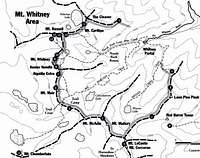
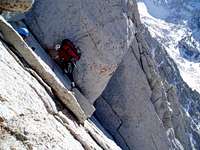
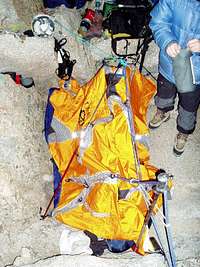


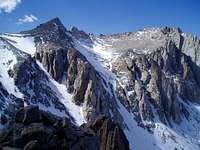
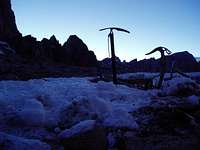



Comments
Post a Comment